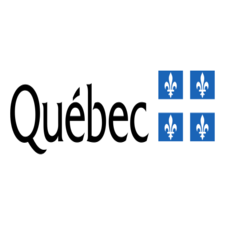Settlement
Type of resources
Topics
Keywords
Contact for the resource
Provided by
Formats
Representation types
Update frequencies
status
-

__The link: *Access the data directory* is available in the section*Dataset Description Sheets; Additional Information*__. Ecoforest maps in PDF format are available at a scale of 1/20,000 and cover Quebec territory approximately up to the 52nd parallel. Each map covers an average area of approximately 250 km2 and presents forest information for the territory concerned. Its accuracy is approximately 10 meters. These maps are an image of the current ecoforest map for the corresponding year. __2021, 2022, 2023 and 2024 cards__ The 2021, 2022, 2023 maps, as well as those of 2024, are produced from the current ecoforest map of the corresponding year. It represents the result of the photo-interpretation of aerial photographs taken during the 4th and 5th ecoforestry inventories of southern Quebec to which were added natural disturbances (fires, epidemics, windfalls, etc.) and forest interventions (harvesting and reforestation) carried out in the public forest following the year in which the picture was taken. According to the maps, data using the forest stand inventory approach (AIPF) is included when available for a complete sheet. Main components: type of vegetation (forest species grouping, density class, height class, age class, etc.) or type of AIPF vegetation (detailed forest species, density (%), height (m), age class, etc.); slope class; type of terrain; nature of the terrain (peatlands, height class, age class, etc.) or type of AIPF vegetation (detailed forest species, density (%), height (m), age class, etc.); slope class; nature of the terrain (peatlands, gravel, etc.); hydrography (lakes, rivers, streams, swamps, etc.); transport network and bridges; topography (level curves); fragmentation. __2019 and 2020 maps__ The 2019 maps, as well as those of 2020, are produced from up-to-date ecoforest maps of the corresponding year. They represent the result of the photo-interpretation of aerial photographs taken during the 4th and 5th ecoforestry inventories of southern Quebec to which were added natural disturbances (fires, epidemics, windfalls, etc.) and forest interventions (harvesting and reforestation) carried out in the public forest following the year in which the photo-interpretation of aerial photographs from the 4th and 5th ecoforestry inventories of southern Quebec were taken. An update is then carried out taking into account natural disturbances (fires, epidemics, windfalls, etc.) and forest interventions (harvesting and reforestation) carried out in public forests. The information presented corresponds to the current ecoforest map of 2019 or 2020 as the case may be. On each map, the name of the stands is expressed by the group of species. Main components: type of vegetation (forest species, density, height, age class, etc.); slope class; type of terrain (peatlands, gravel, etc.); hydrography (lakes, rivers, streams, swamps, etc.); transport network and bridges; topography (level curves); fragmentation. __Maps 2015__ The 2015 maps are produced from the photo-interpretation of aerial photographs from the 3rd and 4th ecoforest inventories of southern Quebec. An update is then carried out taking into account natural disturbances (fires, epidemics, windfalls, etc.) and forest interventions (cutting and planting) carried out in public forests. The information presented corresponds to the 2015 updated ecoforest map. MAP FOR PRINTING (GEOREFERENCED) **This third party metadata element was translated using an automated translation tool (Amazon Translate).**
-

__The link: *Access the data directory* is available in the section*Dataset Description Sheets; Additional Information*__. The original ecoforest map of the third inventory is made from aerial photographs as well as several other products to inform the photointerpreter (forest interventions, information concerning natural disturbances, data from previous inventories, etc.). This map shows the various forest and ecological characteristics of the forest territory and corresponds to the forest profile up to the year in which the aerial photograph was taken. To learn more about ecoforest stratification parameters, simply consult Chapter 3 of the document [*Ecoforest Mapping Standards — Third Ecoforest Inventory (MRNF, 2009) *] (https://mrnf.gouv.qc.ca/documents/forets/inventaire/norme-cartographie-ecoforestiere.pdf). __Note that__ the original ecoforest map of the third inventory has been complete since 2003 and that no new cartographic information has been added since then. Note, however, that improvements were made to the dataset format in 2025.**This third party metadata element was translated using an automated translation tool (Amazon Translate).**
-

__The link: *Access the data directory* is available in the section*Dataset Description Sheets; Additional Information*__. Formerly, forest maps were produced by the Land Survey Department of the Ministry of Lands and Forests. Some of these maps dating **from 1924 to 1946** still exist and are treasured at the National Archives of Quebec. The information they contain makes it possible to locate and characterize forest areas in certain regions of Quebec. Color codes were then assigned for each of the following classes: young forests, old forests, burned, logged, rocky, savannas, and colonization. **These historical forest maps are available in two digital formats (PDF and TIFF) . ** **This third party metadata element was translated using an automated translation tool (Amazon Translate).**
-

This data set contains the polygons delimiting the woods of the agglomeration of Montreal. The boundaries of the woods and their composition are the result of an analysis of aerial photos and/or of field visits and/or of particular ecological studies. These are constantly updated in accordance with the advancement of knowledge in the community. Some plant communities and their limits may therefore be imprecise.**This third party metadata element was translated using an automated translation tool (Amazon Translate).**
-

__The link: *Access the data directory* is available in the section*Dataset Description Sheets; Additional Information*__. The **up-to-date ecoforest map (formerly “with disturbances”) ** is the result of the interpretation of aerial photographs and control points in the field as part of the ecoforest inventory of southern Quebec. This mapping presents the various forest and ecological characteristics of the forest territory and corresponds to the portrait of the forest up to the year in which the aerial photograph was taken (mapping cycle of about 10 years). Next, the outlines and nature of recent disturbances (forest interventions, fires and other disturbances) are then integrated annually. The fifth mapping cycle has been under way since 2015. This map covers almost all of the territory south of the 52nd parallel of Quebec's public and private forest. It is distributed by map sheet at a scale of 1/250,000. The minimum mapping area is 4 ha for stands and 0.1 ha for disturbances. __ ⚠️ 1) Note that__ the disturbance maps used to update the updated ecoforest map are also distributed separately on Data Quebec. Here is the list of these maps: + ** [Forest fires] (https://www.donneesquebec.ca/recherche/dataset/feux-de-foret) ** + ** [Harvesting and other silvicultural interventions] (https://www.donneesquebec.ca/recherche/dataset/recolte-et-reboisement) ** + ** [Epidemics, windfalls and ice storms] (https://www.donneesquebec.ca/recherche/dataset/epidemies-chablis-et-verglas) ** + ** [Forest Infrastructure] (https://www.donneesquebec.ca/recherche/dataset/infrastructures-en-milieu-forestier) ** __ ⚠️ 2) Note that__ disturbances are prioritized according to the nature of the layer and respect for the chronology of events. Only the last original or partial disturbance is kept in the updated ecoforest map. You should refer to the annual update layers, listed in __Note 1__, to have access to the full history of disturbances.**This third party metadata element was translated using an automated translation tool (Amazon Translate).**
-

Treaty/Settlement map (managed forest code 40) used in the Story Map of Forest Management in Canada, 2017. Treaty/Settlement map (managed forest code 40) used in the Story Map of Forest Management in Canada, 2017. Treat/Settlement lands were identified using the Geobase Aboriginal Lands of Canada geodatabase. These are lands owned by a First Nation, Metis or Inuit authority. Source: This web map shows the Treaty/Settlement areas used in the map of forest management in Canada, 2017 and includes the following tiled layer:Treaty/Settlement (Managed Forest Code 40)Data provided by Alberta Agriculture and Forestry; British Columbia Ministry of Forests; Manitoba Sustainable Development; Natural Resources Canada; New Brunswick Department of Energy and Resource Development; Newfoundland & Labrador Department of Fisheries and Land Resources; Northwest Territories Department of Environment and Natural Resources; Nova Scotia Department of Lands and Forestry; Ontario Ministry of Natural Resources and Forestry; Prince Edward Island Department of Communities, Land & Environment; Québec Ministère des Forêts, de la Faune et des Parcs; Saskatchewan Ministry of Environment; and Yukon Energy, Mines and Resources.
-

Treaty/Settlement map (managed forest code 40) used in the Forest Management in Canada, 2020 story map. Treaty/Settlement map (managed forest code 40) using Aboriginal Lands of Canada Legislative Boundaries . These are lands owned by a First Nation, Metis or Inuit authority. The Treaty/Settlement map is used in the Story Map of Forest Management in Canada, 2020 (Aménagement des forêts au Canada, 2020) and includes the following tiled layer: Tile Layer of Treaty Settlement Managed Forest Code 40: 2020
 Arctic SDI catalogue
Arctic SDI catalogue